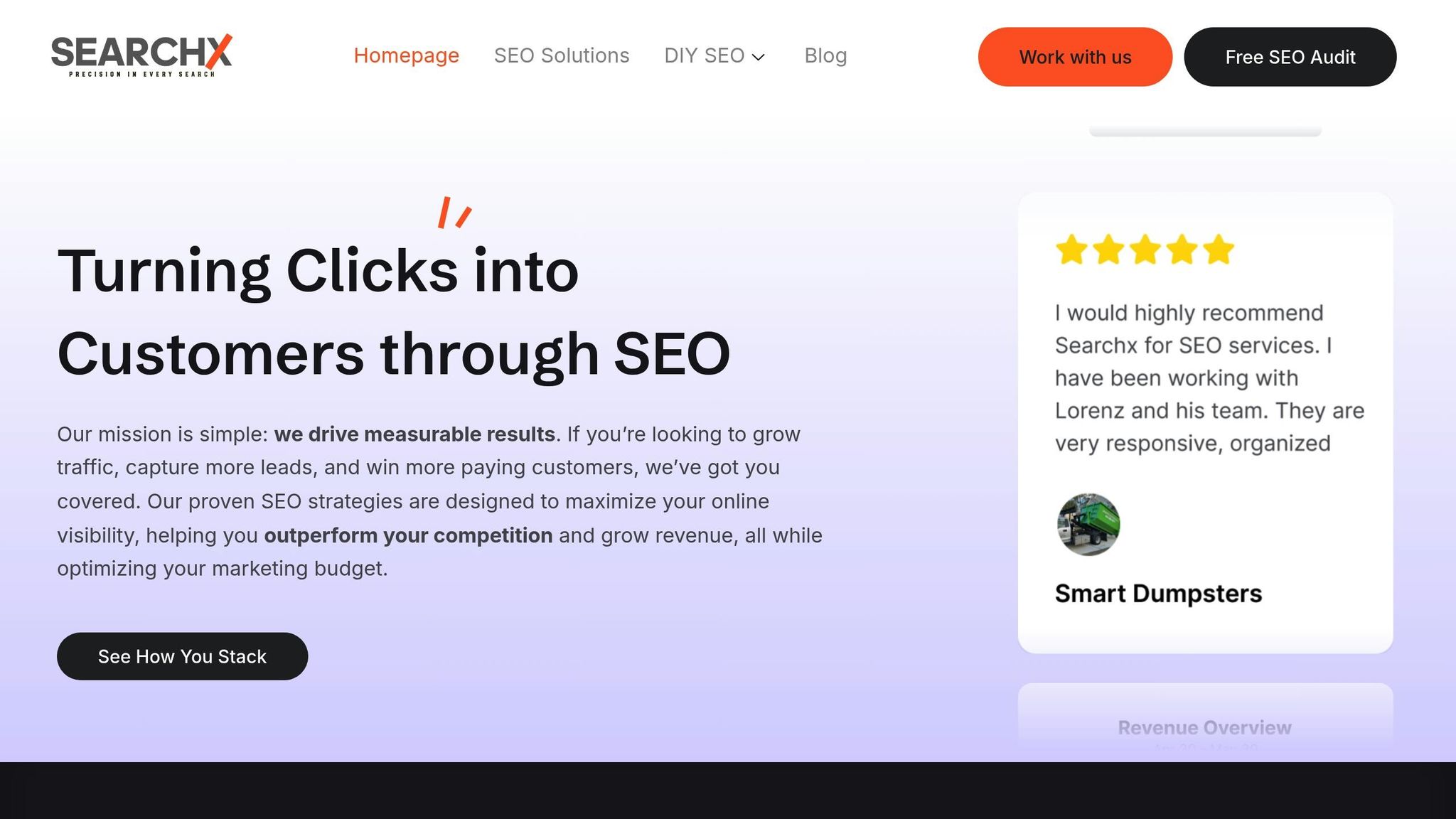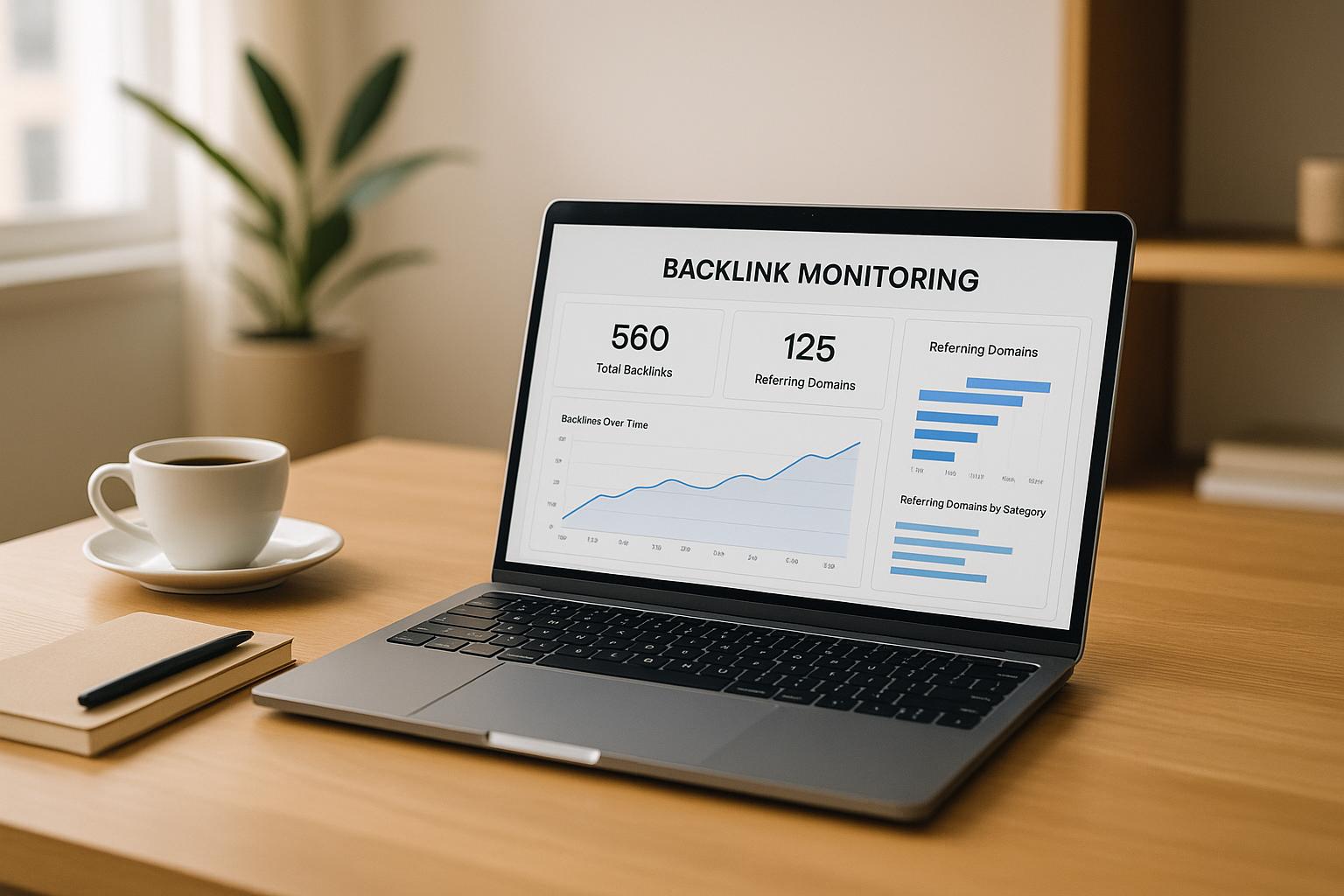Backlink monitoring is critical for SEO success in 2025. It helps you track links pointing to your site, identify harmful backlinks, and maintain your search rankings. With search engines prioritizing link quality over quantity, monitoring your backlink profile is no longer optional – it’s essential for staying competitive.
Key Takeaways:
- Why It Matters: Backlinks are a top-ranking factor. Sites ranked #1 on Google have 3.8x more backlinks than lower-ranking pages.
- Risks of Neglecting: Ignoring backlink monitoring can lead to ranking drops, penalties, and lost trust.
- What to Monitor: Domain authority, link relevance, anchor text diversity, and toxic links.
- Top Tools: Ahrefs, Semrush, Moz Pro, Majestic, SE Ranking, and Linkody. Prices start at $14.90/month.
- Best Practices: Set up automated alerts, perform regular audits, and analyze competitor backlinks.
Quick Comparison of Tools:
| Tool | Starting Price | Strengths | Best For |
|---|---|---|---|
| Ahrefs | $129/month | Frequent updates, accurate data | Agencies, enterprises |
| Semrush | $139.95/month | Largest database, real-time alerts | In-house teams |
| Moz Pro | $49/month | Beginner-friendly, trusted metrics | Small businesses |
| Majestic | $49.99/month | Detailed link metrics | Technical SEOs |
| SE Ranking | $39/month | Affordable all-in-one features | Startups, agencies |
| Linkody | $14.90/month | Lightweight, simple interface | Freelancers, SMBs |
Backlink monitoring isn’t just about tracking links – it’s about protecting your site’s reputation and staying ahead in the competitive SEO landscape.
How to Analyze & Monitor Backlink Profiles with SE Ranking
Key Features of Backlink Monitoring Tools
Backlink monitoring tools have evolved to include advanced metrics, real-time alerts, and seamless integrations. With 70% of marketers finding it challenging to measure the true impact of their link-building efforts, having the right features in your toolkit can help you move from guessing to confidently understanding how your backlink strategy performs.
Important Metrics to Track
To fine-tune your link-building strategy, focus on metrics that highlight both link quality and profile diversity. Some of the most critical ones include:
- Domain Authority (DA) and Domain Rating (DR): These scores are essential indicators of a linking site’s credibility. For example, a backlink from a site with a DA of 80 is far more impactful than one from a DA 20 blog.
- Referring Domains vs. Total Backlinks: This metric reveals the diversity of your link profile. A site with 100 high-quality referring domains often outperforms one with 1,000 backlinks from just five domains. It paints a picture of whether your profile looks natural or overly reliant on a few sources.
- Anchor Text Distribution: A balanced mix of anchor text types – such as exact match, partial match, branded, and generic – is a hallmark of a credible profile. Over-reliance on one type, like 90% guest post backlinks, can appear manipulative.
- Link Relevance: Links from sites related to your niche hold more value. For instance, a fitness blog backlink is far more beneficial for a health supplement store than one from an unrelated site, like a car repair blog.
- Spam and Toxicity Scores: These scores help identify harmful links. For example, backlinks from Private Blog Networks (PBNs) often carry high spam scores. Tools that flag unusual metrics, such as a citation flow of 50 paired with a trust flow of 20, can help you spot and address potential issues.
Tracking new and lost backlinks is equally important. A sudden drop, such as losing 50% of your backlinks after a Google update, could signal an algorithm penalty.
Real-Time Alerts and Automation
Real-time alerts and automation have made backlink monitoring faster and more efficient. Instead of manually checking your backlink profile, these tools keep you informed and ready to act.
- Immediate Notifications: Alerts let you respond quickly to changes. For instance, if a high-authority site links to you, you can take advantage of the momentum. On the other hand, if toxic links appear, you can disavow them before they harm your rankings.
- 24/7 Monitoring: Automated tools continuously track your backlink status, ensuring you never miss critical updates about your SEO performance.
- Customizable Alerts: You can tailor notifications to your needs, such as setting alerts for new links from sites with a DR above 50 or for lost links from your top referring domains. This helps you stay focused without being overwhelmed by unnecessary updates.
- Automated Outreach Management: These systems simplify link-building campaigns by identifying high-quality domains, managing outreach, and even sending follow-up reminders. This automation frees you up to focus on building genuine relationships.
Integration with SEO Platforms
Backlink monitoring tools also shine when they integrate with broader SEO platforms, offering a more comprehensive view of your performance.
- Google Search Console Integration: While Google Search Console provides an official view of your backlinks, it lacks advanced metrics like DA or spam scores. Pairing it with tools like Ahrefs, SEMrush, or Moz gives you a complete picture, combining Google’s data with detailed quality insights.
- Cross-Platform Data Sharing: Integrated tools eliminate the hassle of manually importing and exporting data. When your backlink monitor syncs with rank tracking, content management, and analytics platforms, you can easily see how link changes impact traffic, rankings, and conversions.
- Competitive Intelligence: By sharing data with competitive analysis tools, you can uncover new backlink opportunities. For example, identifying the sources of your competitors’ links can help you target similar opportunities.
When these features work together – tracking metrics, sending alerts, and integrating seamlessly with your existing SEO tools – backlink monitoring becomes less of a chore and more of a strategic advantage. It transforms the way you manage and optimize your link-building efforts.
Top Backlink Monitoring Tools in 2025
Backlink monitoring tools in 2025 range from all-in-one SEO platforms to specialized options. For instance, Semrush tracks an impressive 43 trillion links, while Ahrefs crawls over 6 billion pages every single day.
Tool Comparison Chart
Choosing the right backlink tool means understanding what each one brings to the table and how it fits your specific needs. Here’s a quick comparison of the top tools available in 2025:
| Tool | Starting Price | Notable Strengths | Database Size | Best For | Update Frequency |
|---|---|---|---|---|---|
| Ahrefs | $129/month | Precise data, industry benchmark | 30.3 trillion backlinks | Agencies, enterprise users | Every 15-30 minutes |
| Semrush | $139.95/month | Largest database, toxic link alerts | 43 trillion backlinks | In-house marketing teams | Real-time updates |
| Moz Pro | $49/month | Easy to use, trusted authority data | 45.5 trillion links | Small businesses, beginners | Daily updates |
| Majestic | $49.99/month | Trust Flow & Citation Flow metrics | Billions of links | Technical SEOs, analysts | Continuous crawling |
| SE Ranking | $39/month | Affordable all-in-one features | Comprehensive coverage | Startups, mid-size agencies | Regular updates |
| Linkody | $14.90/month | Simple interface, lightweight tool | Focused dataset | Freelancers, small businesses | Daily monitoring |
Each tool offers unique benefits. A 2024 study showed Semrush uncovered more backlinks for 87% of websites compared to Ahrefs. However, Ahrefs’ frequent updates (every 15–30 minutes) make it an excellent choice for real-time monitoring. For those on a tight budget, Google Search Console remains a reliable free option for basic backlink data.
How to Choose the Right Tool
When selecting a tool, consider your business size and goals. A survey found that 76.92% of SEO experts prioritize monitoring new backlinks, while 72.31% focus on ensuring links come from trustworthy, relevant sites.
- For Small Businesses & Freelancers: Moz Pro ($49/month) is a beginner-friendly option with trusted metrics, while Linkody ($14.90/month) offers essential monitoring without unnecessary complexity. SE Ranking ($39/month) is another affordable choice, combining multiple SEO tools in one platform.
- For Mid-Size Agencies: Majestic stands out with its Trust Flow and Citation Flow metrics, ideal for detailed link analysis. SE Ranking is also a strong contender for agencies needing an all-in-one solution.
- For Enterprises & Large Agencies: Ahrefs and Semrush are the go-to options. Ahrefs is known for its accuracy and quick updates, while Semrush provides a comprehensive suite, including backlink audits, keyword tracking, and competitor analysis.
Scalability is key, especially for growing businesses. As SEO expert Jason Acidre points out:
"Finding link opportunities isn’t the hard part. Finding them efficiently across different industries while keeping outreach personalized is the real challenge. Without good systems, you just can’t scale."
For those looking to take their strategy further, specialized services like SearchX can provide additional support.
How SearchX Supports Backlink Monitoring

SearchX integrates backlink monitoring into a broader SEO strategy, offering actionable insights and continuous improvements. Instead of treating backlink monitoring as a standalone task, they combine it with other SEO efforts to maximize results.
- Comprehensive Link Building Services: SearchX focuses on gaining high-quality, relevant backlinks while keeping an eye on the health of your existing link profile. Their link building services ensure a balanced approach to growth.
- Technical SEO Integration: By addressing website issues that could impact link value, their technical SEO services ensure backlinks deliver maximum impact.
- Scalable Monitoring Solutions: Whether you’re a startup or an enterprise, SearchX offers solutions tailored to your growth stage. Packages start at $3,000/month (Starter), $6,000/month (Growth), and $12,000+/month (Enterprise). Features include competitor analysis, advanced monitoring, and custom reporting dashboards.
- Industry-Specific Expertise: SearchX tailors strategies to the unique demands of different industries, ensuring your backlink profile aligns with your market’s dynamics.
- Actionable Reporting: Beyond just providing data, SearchX translates insights into strategic recommendations, helping you improve rankings and drive organic traffic.
sbb-itb-880d5b6
Best Practices for Backlink Monitoring
Keeping tabs on your backlinks isn’t just about occasional checks. The best SEO experts use structured methods to spot issues early and turn data into actionable strategies.
Setting Up Automated Alerts
Manually checking backlinks becomes impractical as your site expands. That’s where automated alerts come in – they monitor your backlinks around the clock and notify you of any important updates.
Set up alerts for three key scenarios: new backlinks, lost backlinks, and unlinked mentions. New backlink alerts let you track your growth and confirm that your link-building efforts are working. Lost backlink alerts help you act quickly – sometimes a simple email to the site owner can recover a valuable link. Unlinked mentions are golden opportunities for outreach since the site is already familiar with your brand.
"I used this tool, and it’s quite good for backlink analysis, especially love the email notification feature to lose or gain new backlinks."
– Real Customer, Backlink Monitor
Most SEO tools let you customize how often you receive alerts. For high-priority domains, daily notifications work best, while weekly summaries are great for general updates. Striking the right balance is essential – too many alerts can overwhelm you, while too few might let critical changes slip past unnoticed.
Automated alerts also help you catch harmful links early, protecting your site from negative SEO attacks. Without these alerts, spammy backlinks could go undetected for months, potentially damaging your rankings. Once your alerts are set, periodic audits ensure your backlink profile stays clean and strong.
Regular Backlink Audits
How often should you audit your backlinks? For most sites, monthly audits are a good starting point, but you can adjust based on your website’s size and activity level.
If you’ve just wrapped up a major link-building campaign, plan an audit within the next month or two. This helps you confirm that new links meet quality standards and catch any low-quality links that may have slipped through.
Websites that conduct quarterly audits see 34% fewer ranking drops after major algorithm updates. Plus, regular audits save time and money. A quarterly audit typically takes 15–25 hours, while recovering from a penalty might take 80–120 hours and cost anywhere from $5,000 to $20,000.
Here’s a startling fact: Ahrefs found that 67% of domains analyzed over the past decade have at least one toxic backlink.
"Regular checks help identify and address any harmful links, monitor the quality of your backlinks, and ensure your SEO strategy remains effective."
– Uzair Baig, SEO Team Lead at Ashar Group
Trigger-based audits provide an extra layer of security. For instance, when Google announces a major algorithm update, schedule an immediate audit. These insights allow you to fine-tune your strategy and maintain strong SEO performance.
Using Competitor Analysis
Monitoring your own backlinks is crucial, but comparing your profile to competitors can take your strategy to the next level. On average, the top-ranking page on Google has 3.8× more backlinks than other pages. Studying how competitors earned those links can offer a roadmap for your own efforts.
Start by identifying your competitors at both the domain and page levels. Then, analyze their backlinks based on factors like domain rating, traffic, dofollow vs. nofollow ratios, anchor text, link placement, and relevance. One of the most valuable insights is the competitor backlink gap – these are sites linking to your competitors but not to you.
"If you’re looking to build more backlinks to your website, checking how your competitors built and earned their backlinks is a good starting point."
– Joshua Hardwick, Head of Content @ Ahrefs
Set monthly backlink goals based on competitor analysis. Top-ranking pages typically see a 5%–14.5% increase in dofollow backlinks each month. If you notice a sudden spike in a competitor’s backlinks, it could signal a successful content campaign or partnership you might replicate.
"Backlinks remain the best indicator to Google and other search engines that a webpage is considered important by internet users. Links can be compared to votes, only when it comes to backlinks votes are not equal. The more relevance and authority a website has, the more weight the vote gets."
– Andy Hill, Managing Director, Distribute Digital
Competitor backlinks can also reveal gaps in your content. Track both lost and gained backlinks for your competitors. If they lose a valuable link, you might step in with better content or a stronger pitch. If they gain new links, study what made their content appealing and use that insight to refine your own outreach and content strategies.
Tools like Ahrefs are particularly useful for this kind of analysis – 64% of SEO professionals rely on it for its link data. Regular competitor reviews help you spot patterns, document strategies, and create targeted outreach plans that keep your SEO efforts on track.
Understanding Backlink Data and Taking Action
Once your monitoring and audits are in place, it’s time to dig into the data and make it work for you. Raw backlink numbers alone won’t cut it – you need to interpret what the metrics reveal and use those insights to guide your strategy. Here’s a closer look at key metrics, handling harmful links, and uncovering fresh link-building opportunities.
Understanding Backlink Metrics
Backlink metrics are like a report card for your site’s authority and potential to rank well. They provide a clearer picture of how your site is performing and where it can improve.
Domain strength is one of the first things to evaluate. In a survey, 69% of SEO professionals recognized Ahrefs’ Domain Rating (DR) as the go-to metric for assessing domain authority, while 65% of marketers agreed that domain authority is a critical factor in judging backlink quality. Tools like Ahrefs’ DR and Moz’s Domain Authority (DA) can help you gauge your site’s strength, with DR offering a sharper focus on your backlink profile.
Relevance is king when it comes to backlink quality. A link from a tech publication will carry far more weight for a software company than one from a high-traffic cooking blog. It’s all about staying within your niche.
Link placement and type also matter. Links embedded in the main body of a page, especially those placed higher up, are more engaging for users and tend to get more attention from search engines. While the debate over nofollow links continues, nearly 89% of link builders believe they still have an impact on rankings.
Organic traffic quality is another key factor. Backlinks from sites with engaged audiences are more impactful. It’s not just about traffic volume – 10,000 monthly visitors from your target audience are far more valuable than 50,000 visitors from unrelated topics.
These metrics provide a roadmap for addressing toxic links and finding new opportunities. After all, Google’s top-ranking pages have 3.8 times more links than lower-ranking results, and 58% of businesses say link building significantly influences their rankings.
Handling Toxic Links
Toxic backlinks can drag down your rankings, so knowing when and how to deal with them is crucial. Not every questionable link requires action, but identifying genuine threats is key.
Spotting harmful links means looking beyond automated warnings. Interestingly, 38% of SEO specialists don’t act on spammy backlinks, while another 38% opt to disavow them. This divide shows there’s no universal solution.
Here are some red flags to watch for:
| Red Flag | What It Looks Like | Why It’s Harmful |
|---|---|---|
| Spammy Content | Keyword stuffing, duplicate or thin articles | Indicates low-quality, manipulative practices |
| Irrelevant Topics | Links from unrelated industries or niches | Appears unnatural to search engines |
| Excessive Ads | Ads overshadowing actual content | Suggests profit focus over value |
| Missing Contact Info | No email, phone, or contact form | Signals lack of transparency |
| Outdated Design | Broken layouts, old-fashioned appearance | Often points to neglect or abandonment |
Removing toxic links typically starts with direct outreach. Contact the site owner and politely request the removal of harmful links before turning to Google’s Disavow Tool. A clear and respectful message increases your chances of success.
Google’s Disavow Tool should be your last resort. Google advises using it only if you face a manual action for unnatural backlinks or have purchased links in the past. When using the tool, it’s usually better to disavow entire domains rather than individual URLs.
"This is an advanced feature and should only be used with caution. If used incorrectly, this feature can potentially harm your site’s performance in Google Search results." – Google
"Most backlinks, even in a worst-case scenario, will not cause negative SEO, but rather will just be ignored by Google." – Becky Halls, SEO & UX Strategist
Building a strong, natural link profile can make occasional toxic links irrelevant. However, if you receive a manual action, it’s essential to clean up the harmful links quickly.
Finding New Link Opportunities
Once your backlink profile is clean, the next step is to strengthen it with high-quality links. This involves more than just monitoring metrics – it requires a proactive approach to uncover new opportunities.
Here are some effective strategies:
- AI-powered prospecting: Leverage AI tools to find websites that align with your niche and outreach goals. Predictive analytics can also help you identify trending topics and formats that are likely to attract backlinks.
- Local connections: Reach out to local businesses, community websites, and regional publications. These links are often highly relevant and face less competition.
- Content-driven strategies: Create exceptional content that naturally attracts backlinks. Guest posting on reputable sites can also be effective, especially when you build authentic relationships with site owners.
- Broken link building: Look for broken links on other sites and suggest your content as a replacement. This benefits both you and the site owner.
- Unlinked mentions: Monitor for mentions of your brand that aren’t hyperlinked, and ask for a link to be added.
- Social platforms: Use platforms like TikTok and Instagram to produce shareable content. Collaborating with nano and micro-influencers can also expand your reach.
Ultimately, successful link building is about forming genuine partnerships with those who value your content. Regularly reviewing your backlink profile ensures your links remain high quality and aligned with your SEO goals. It’s worth noting that nearly 85% of marketers see link building as a critical factor in boosting their brand’s visibility.
Conclusion: Mastering Backlink Monitoring in 2025
Backlink monitoring isn’t just another SEO task – it’s the backbone of maintaining strong search visibility in 2025. With only 2.2% of online content earning links from other sites, those who excel at tracking and building high-quality backlinks gain a clear edge over their competitors.
The numbers speak for themselves: 91% of experts agree that link-building is effective or very effective for improving search rankings, and 94% of marketers believe backlinks will remain a key ranking factor for Google in the years ahead. Even more striking, pages ranked #1 on Google have 3.8 times more links than those in positions 2–10. These statistics highlight how critical backlinks are for boosting search performance.
Consistency is the key to success. The best SEO professionals know that monitoring backlinks isn’t a one-and-done process – it requires ongoing effort. Surveys reveal that 76.92% of SEO experts track new backlinks, while 72.31% monitor link quality to ensure links come from trusted and relevant sites.
As search engines evolve, especially with AI-powered features, backlinks play an even bigger role in identifying trustworthy sources. Search algorithms are now prioritizing quality over quantity more than ever before. To stay ahead, your monitoring strategy needs to focus on relevance and trustworthiness rather than chasing sheer numbers. Building authority through authentic, meaningful connections will always outlast quick-fix tactics. This guide’s strategies are designed to help you adapt to these shifting priorities.
Success lies in action. Use the tools and techniques outlined here: set up automated alerts, schedule regular audits, and make competitor analysis a habit. These practices turn raw data into tangible results. And with 92% of marketers predicting that link-building will remain critical to Google’s ranking algorithm for the next five years, there’s no better time to refine your approach.
SEO expert Georgi Todorov emphasizes this point:
"Choosing a backlink monitoring tool that suits your needs is key for long-term SEO success. From personal experience, maintaining an active approach to backlinks can significantly improve your site’s SEO performance. Select a tool that will be suitable for you, make backlink monitoring a regular habit, and the results will speak for themselves!"
Your backlink profile is more than just links – it’s your site’s digital reputation. By selecting the right tools, making monitoring a regular practice, and committing to consistent, high-quality efforts, you’ll solidify your site’s authority and sustain its search visibility well into 2025 and beyond.
FAQs
What should I consider when choosing the right backlink monitoring tool for my business?
When choosing a backlink monitoring tool, start by aligning your choice with your business goals and SEO priorities. Look for essential features like in-depth backlink analysis, robust reporting options, and seamless integration with your existing SEO efforts. Don’t overlook your budget – the tool should deliver good value and fit within your financial plans. Some tools cater to advanced needs, while others are designed for more straightforward tasks, so it’s important to match the tool to your expertise and specific requirements.
Another critical factor is scalability. As your business expands, you might need access to more advanced functionalities or increased limits. Opt for a tool that can adapt to your growing needs. By weighing these considerations carefully, you can select a tool that enhances your backlink strategy and supports your long-term goals.
What risks might you face if you skip backlink monitoring in 2025?
In 2025, ignoring backlink monitoring could put your website at serious risk. You could end up with toxic backlinks that damage your site’s credibility and even trigger SEO penalties. On top of that, without keeping an eye on your backlinks, you might lose valuable links, which can hurt your search rankings and reduce your site’s visibility.
To keep your online presence strong, make it a priority to perform regular backlink audits. These audits help you spot and deal with harmful links while ensuring your SEO efforts remain effective and in line with search engine rules.
What’s the best way to identify and deal with harmful backlinks to safeguard my website’s SEO?
To spot harmful backlinks, leverage backlink analysis tools to examine your site’s link profile. Look for links that come from spammy, irrelevant, or low-quality sources, especially those that might go against search engine guidelines.
After identifying these problematic links, you have two main options: either contact the site owners and request the removal of the links, or use the disavow tool in Google Search Console to neutralize their impact on your SEO. Keeping a close eye on your backlink profile regularly is essential to safeguard your site from penalties and maintain strong SEO health.




